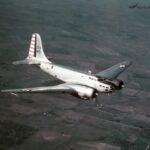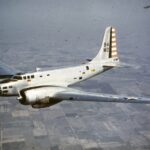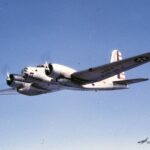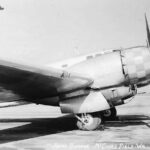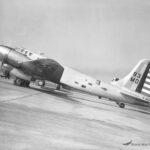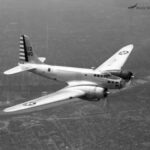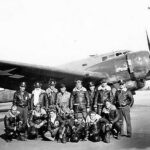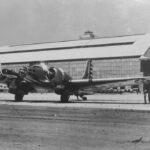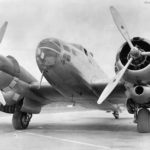B-23 MD94
B-23 MD94
B-23 MD94
B-23 McChord
MD93 May 1941
B-23 112 May 1941
B-23 112 May 1941
B-23 crew
B-23 137
B-23 on the ground
B-23 Dragon
B-23 38-27 in flight, 29 August 1940
Douglas B-23 #93
Douglas B-23 Dragon #15 2
B-23 Dragon, 11 December 1939
Members of 95th Bomb Squadron and B-23 at McChord Field, Tacoma 1941
B-23 39-53 dropping 4000 lb bomb at Aberdeen Proving Ground 1942
B-23 Dragon left side view
B-23 Dragon #15 frontal view
B-23 Dragon was a twin-engined bomber developed by Douglas Aircraft Company as a successor to the Douglas B-18 Bolo.
Douglas and the Army Air Corps quickly realized that the B-18 series was becoming outdated. To address this, Douglas proposed enhancing the bomber’s capabilities by equipping the B-18A variant with more powerful 1,600 hp Wright R-2600-2 engines, leading to the planned B-22 designation. Despite the increase in power, the projected performance did not meet Air Corps standards, so the development of the B-22 was discontinued. Instead, Douglas suggested a significant redesign, which incorporated stronger wings from the DC-3, a newly streamlined fuselage, and a larger fin and rudder. This redesign resulted in the B-23, which was ordered in late 1938. A contract modification replaced thirty-eight B-18As with the B-23 (serial numbers 2713 to 2750, and 39-27 to 39-64). Unlike most new aircraft, the B-23 was ordered without prototype and Service trials versions, which would have been designated XB-23 and YB-23, respectively. Production began, and the first B-23, powered by two 1,600 hp Wright R-2600-3 engines, was completed in July 1939 and first flown on July 27 at Clover Field, Santa Monica.
The initial B-23 lacked a glazed nose, which was later added to production models to house the bomb aimer’s station and a flexible 0.30-inch machine gun. In service, the B-23s also featured a light machine gun mounted on the aft fuselage bulkhead, which could be fired through side hatches or a dorsal panel, along with a third 0.30-inch gun in a ventral hatch. Notably, the B-23 was the first American bomber to include a tail gunner position equipped with a hand-held 0.50-inch machine gun. Besides its bombing role, with a bomb bay capable of holding up to 2,000 lb (908 kg) of bombs behind the pilot’s compartment, the B-23 was also designed for photographic reconnaissance, with a camera permanently mounted on the left fuselage near the forward bulkhead. The crew typically consisted of a pilot, bomb-aimer, navigator, radio operator, camera operator, and gunner.
After evaluation by the Materiel Division at Wright Field, Ohio, the B-23s entered service in 1940 with the 89th Reconnaissance Squadron at March Field, California. However, by 1941, despite its top speed of 282 mph (454 km/h) being 66 mph (106 km/h) faster than the B-18A and its maximum range of 2,750 miles (4,425 km) exceeding that of its predecessor, the B-23 was still inferior to the B-17E, the first fully representative wartime Flying Fortress model. As a twin-engine medium bomber, the B-23 was also slower than the North American B-25 and Martin B-26, and it had lighter defensive armament compared to these newer models. As a result, the Army Air Forces repurposed the B-23 for special tests and conversions.
At least eighteen B-23s were converted into transports under the UC-67 designation, a category of aircraft that became urgently needed at the onset of the war. Some B-23s were used in special tests, such as glider pick-up tests on aircraft 39-28. This involved catching a glider’s tow line, suspended between two poles, with a hook mounted beneath the rear fuselage, enabling the B-23 to tow the glider without landing. Emerson Electric also used 39-28 to test remote gun control and aiming systems. The sixth B-23 (serial 39-32) was handed over to Pratt & Whitney on August 20, 1940, to test the 1,850 hp R-2800-5 engine in support of the B-26 and XB-28 programs, and it was tested with both three-blade and four-blade propellers. Additionally, aircraft 39-53 was used at Muroc Dry Lake, California, as a control ship for the Culver PQ-8 radio-controlled target.
After the war, B-23s and UC-67s were sold as surplus and were quickly repurposed as corporate aircraft. Many of these aircraft were modified by Pan American Airways’ Engineering Department for their new role, including the addition of a new and longer metal nose. As corporate aircraft, they were outfitted with a crew of two, full washroom facilities, and accommodations for twelve passengers in two compartments. Some of these civil B-23s were still operational in the early 1970s. Almost thirty years after being declared surplus, one aircraft, registered N52327 (c/n 2722, ex 39-36), was used in 1974 by the University of Washington for the Air Force Cambridge Research Laboratory. This heavily instrumented aircraft, crewed by a pilot, copilot, and five engineers, was employed to sample cloud particles as part of a research project sponsored by the Space and Missile Systems Organization’s Advanced Ballistic Reentry Systems Program Office.
The B-23 had a wingspan of 92 ft (28.04 m), a length of 58 ft 4 in (17.79 m), a height of 18 ft 5.5 in (5.63 m), and a wing area of 993 sq ft (92.25 sq m). It had an empty weight of 19,089 lb (8,659 kg), a loaded weight of 26,500 lb (12,020 kg), and a maximum weight of 32,400 lb (14,696 kg). The wing loading was 26.7 lb/sq ft (130.3 kg/sq m), and the power loading was 8.3 lb/hp (3.8 kg/hp). The aircraft could reach a maximum speed of 282 mph (454 km/h) at 12,000 ft (3,660 m), with a cruising speed of 210 mph (338 km/h). It could climb to 10,000 ft (3,050 m) in 6.7 minutes and had a service ceiling of 31,600 ft (9,630 m). Its normal range was 1,400 miles (2,255 km), with a maximum range of 2,750 miles (4,325 km).
Total production: 38
USAAC serials: 39-27 – 39-64
